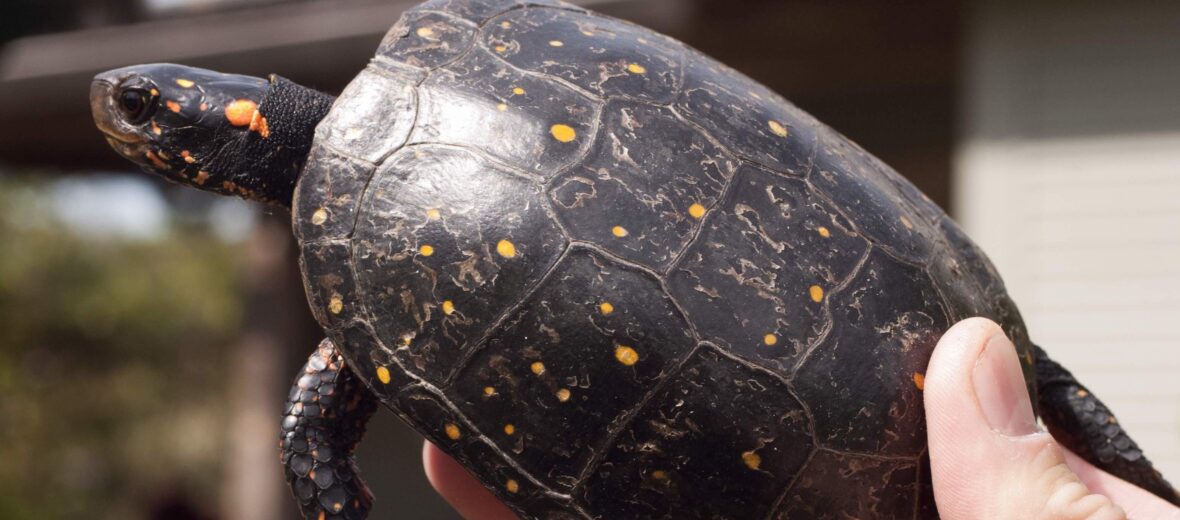
The spotted turtle is a small, semi-aquatic turtle that hails from Canada and the eastern United States. They prefer marshes, flooded forests, wet meadows, bogs, and woodland stream habitats. Unfortunately, these little turtles face a host of threats. They are faced with habitat loss at the hands of residential and commercial development and agricultural needs; habitat division due to road and railroad development, which also results in vehicle strike (being hit with vehicles); ecosystem modifications; overfishing; invasive species (and with them disease, predation, and competition for food); pollution; and climate change (which can alter their habitats via droughts and flooding). The IUCN lists these little turtles as Endangered. Their populations are also decreasing.
First the Stats…
Scientific name: Clemmys guttata
Weight: Up to .75 lb.
Length: Up to 4.5 inches
Lifespan: Up to 50 years
Now on to the Facts!
1.) They like sedge tussocks (vegetation that is compact, tufted, or clumped), soft muddy soil, and habitats with water lilies, sphagnum moss, and cattails.
2.) These turtles are diurnal (active during the day).
3.) Spotted turtles aestivate (a brief dormant period) for extended periods of time when the temperatures reach 86°F.
4.) During the summer months, they can often be found burrowing into leaf litter in marsh edges, woodlands, open fields, or taking up residence in muskrat burrows & other aquatic hides.
5.) While typically solitary, they have also been known to bask in communal locations. They also come together when food is abundant, and will often times brumate (brief hibernation for reptiles) and hibernate in small groups.
But wait, there’s more on the spotted turtle!
6.) These little critters hunt for prey primarily only in the water. Their prey of choice are worms, slugs, millipedes, aquatic insect larvae, spiders, crustaceans, tadpoles, salamanders, and small fish. Aquatic vegetation, and green algae is also on the menu for these omnivores (eat plant and animal matter).
7.) Due to their diminutive size, these turtles are highly subjected to predation while on land. When threatened, they will dive into the water and bury themselves in the mud till the danger has passed.
Did you know…?
Another threat these turtles face is illegal collection for the pet trade.
8.) Their primary predators are raccoons, muskrats, birds of prey, and larger fish.
9.) A group of turtles is called a bale, creep, dole, nest, or turn.
10.) Spotted turtles breed from March – May.
But wait, there’s still more on the spotted turtle!
11.) Females are gravid (pregnancy for reptiles) for up to 77 days.
12.) The females lay up to 7 eggs that hatch in up to 11 weeks.
Did you know…?
When tested in mazes, these turtles have shown a high intelligence and an ability to solve maze puzzles. In fact, they are as smart as mice.
13.) Hatchlings are precocial (totally self sufficient).
14.) The gender of the hatchlings are directly correlated to the ambient temperature. Cooler temps result in more male turtles, while warmer temps yield more females. This is called temperature-dependent sex determination, or TSD.
15.) Their carapace spots vary substantially based on their geographic range. Some have upwards of 100+ spots, while others have no spots at all.
Now a Short Spotted Turtle Video!
Be sure to share & comment below! Also, check out the Critter Science YouTube channel. Videos added regularly!
Want to suggest a critter for me to write about? Let me know here.
Some source material acquired from: Wikipedia & IUCN
Photo credit: Vermont Reptile and Amphibian Atlas



